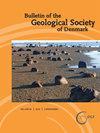法罗群岛的威奇塞利冰川
IF 1
4区 地球科学
Q2 Earth and Planetary Sciences
引用次数: 0
摘要
本文介绍了法罗群岛冰川景观、地貌和沉积物的新的完整野外测绘,并辅以法罗大陆架测深图的观测结果。此外,还回顾了以往对第四纪的研究,特别是对该群岛韦氏冰川作用的研究。新的宇宙成因核素暴露年龄表明,法罗群岛最后一次大范围冰川作用发生在魏克塞利晚期,很可能发生在最后一次冰川盛期(LGM;c.26.5–19.0 cal.ka BP),尽管不能完全排除较年轻的Dryas(c.12.9–11.7 cal.kb BP)年龄。地貌测绘为重建法罗群岛冰川作用的范围和类型提供了背景。重建后的韦氏冰川作用似乎具有延伸山谷冰川作用的特征,有几个海洋冰川终止。斯瓦尔巴群岛斯匹次卑尔根岛南部目前的冰川作用,代表了法罗群岛重建的韦氏冰川作用的现代相似性。法罗群岛也在保护区缺乏凸起的海岸特征,这表明冰川后均衡隆起小于LGM后海平面上升。对上一次大规模法罗群岛冰川作用的不同程度进行的冰川重建表明,这种有限的冰后均衡地壳抬升要求法罗大陆架在晚魏克塞利亚期没有受到广泛的冰川作用,但毫无疑问,至少在前一次第四纪冰川作用期间是如此。本文章由计算机程序翻译,如有差异,请以英文原文为准。
Weichselian Glaciation of the Faroe Islands
This paper presents a new complete field mapping of glacial landscapes, landforms and sediments in the Faroe Islands, supplemented by observations from bathymetric maps of the Faroe Shelf. In addition, previous investigations of Quaternary and espe-cially the Weichselian glaciation of the archipelago are reviewed. New cosmogenic nuclide exposure ages indicate that the last extensive glaciation of the Faroe Islands occurred during the Late Weichselian, most likely during the Last Glacial Maximum (LGM; c. 26.5–19.0 cal. ka BP), although a Younger Dryas (c. 12.9–11.7 cal. ka BP) age cannot be entirely excluded. Geomorphological mapping provides a background for reconstructing the extent and type of the glaciation of the Faroe Islands. The reconstructed Weichselian glaciation appears to have had the character of an exten-sive valley glaciation, with several marine glacier termini. The present glaciation of southern Spitsbergen, Svalbard, represents a modern analogue of the reconstructed Weichselian glaciation in the Faroe Islands. The lack of raised coastal features in the Faroe Islands, also at protected sites, suggests that postglacial isostatic uplift was smaller than post-LGM eustatic sea level rise. Numerical glacier reconstructions carried out for different extents of the last extensive Faroese glaciation suggest that such limited postglacial isostatic crustal uplift requires that the Faroe Shelf was not extensively glaciated during the Late Weichselian, but it doubtless was so during at least one of the previous Quaternary glaciations.
求助全文
通过发布文献求助,成功后即可免费获取论文全文。
去求助
来源期刊

Bulletin of the Geological Society of Denmark
GEOSCIENCES, MULTIDISCIPLINARY-
CiteScore
2.80
自引率
16.70%
发文量
28
审稿时长
>12 weeks
期刊介绍:
The Bulletin publishes contributions of international interest in all fields of geological sciences on results of new work on material from Denmark, the Faroes and Greenland. Contributions based on other material may also be submitted to the Bulletin if the subject is of relevance for the geology of the area of primary interest.
 求助内容:
求助内容: 应助结果提醒方式:
应助结果提醒方式:


